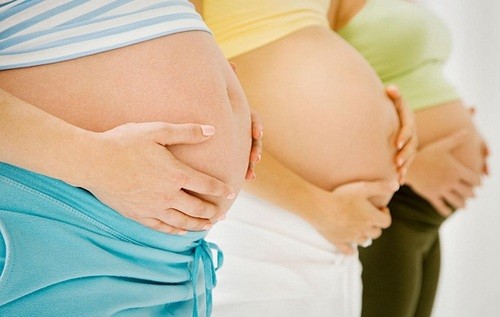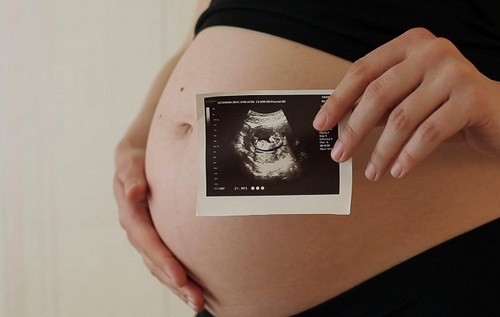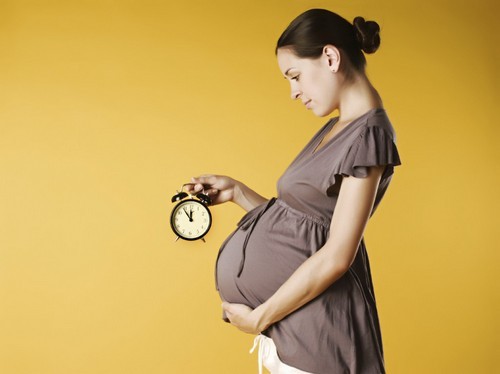At 40 weeks of gestation, the full development and formation of the fetus occurs. However, the likelihood that he will be born during this week is negligible.
According to statistics, only 5% of women have labor at this time, the rest either give birth earlier or later for 2 to 3 weeks.
And this is completely normal, there are no reasons for worries. Most likely, this is due to an incorrect deadline, and not with deviations. A lot of women give birth and at 41 – 42 weeks, and this is also considered normal.
How the expectant mother feels
This period is difficult for a woman. The abdomen is stony, becomes very large and prevents free movement. Some women at this time cannot even get out of bed or get dressed on their own. Constantly worried about aching pain in the lower back and joints. At the same time, pain can be given both in the arm and in the leg.
Most women complain that at this time their stomach seems to be stony. This is completely normal. And this is due to the lowering of the abdomen and an increase in the tone of the uterus.
By the end of 39 weeks, a pulling sensation in the lower abdomen may appear – this is a sign that the cervix softens, preparing for the onset of labor. In addition, pain may occur in the perineum and lower body. During this period, the fetal head exerts great pressure on the pelvic floor. As a result, severe pains are formed in the sacral region, since the hip joint is jammed due to pressure.
Every day, an increase in pressure on the veins of the pelvis increases, which leads to the filling of hemorrhoidal nodes. As a result, painful nodules appear in the anus, which leads to slight bleeding during bowel movements.

Compression of the femoral veins prevents normal blood flow in the lower extremities. Which, as a rule, leads to temporary numbness of the legs.
At 39 – 40 weeks of pregnancy, the woman’s mammary glands are completely ready for breastfeeding. During this period, colostrum appears, which can provide the baby with all the necessary substances from the first days of his life. Then, approximately 3 to 5 days after birth, colostrum replaces milk.
Future mothers need to remember that during this period all the inconveniences and unpleasant sensations should be urgently reported to the doctor. After all, it can be both characteristic events of the final stage of pregnancy, and a “signal”, portending the imminent opening of labor.
How does the fetus feel?
By the end of 39 weeks, the fetus is fully formed. His height is approximately 50 – 55 cm, and weight 3200 – 3500 kg. He already has little space in the uterus, so his movements are limited. But this does not mean at all that the baby’s activity is reduced. On the contrary, it begins to move more often, mainly with arms and legs. In case of decreased motor activity, you should immediately visit a doctor.
However, excessive fetal activity may indicate a lack of oxygen, which is typical for 39 – 40 weeks of pregnancy. During this period, the placenta is no longer able to fully cope with its duties, as a result of which the child experiences tremendous oxygen starvation, which can lead to serious impairment of the brain activity of the fetus, the work of his heart and other organs. And in severe cases, prolonged oxygen starvation completely leads to the death of the child.
At this time, the utero-placental barrier is violated due to a decrease in the wall thickness of the placenta, which protects the baby from infections and the penetration of toxic substances. The consequences of this are the unhindered penetration of pathogenic microorganisms into the fetus, which lead to the development of intrauterine infection.

Harbingers
As a rule, literally a week before the onset of childbirth, the stomach becomes stony, and the woman begins to actively lose weight. This is not a big deal, unless, of course, the pregnant woman’s weight has decreased by more than 5–10 kg. Otherwise, urgent hospitalization is required.
Weight loss occurs due to the release of excess fluid from the body. It manifests itself as frequent urination and excessive sweating, especially if when 39 – 40 weeks of pregnancy occur in the summer.
About 3 to 4 weeks before birth, aching pains appear in the lower back and lower abdomen, resembling cramping during menstruation. Periodically there is pain in the pubic area and a feeling of fullness. This is due to the pressure of the fetus on the pelvic floor.
Oddly enough, as a rule, those women for whom childbirth is not the first to respond to false contractions, as they already know what to expect and monitor all the processes in the body more closely. Accompanied by pain or simply unpleasant sensations in the lower abdomen. It is very easy to identify false contractions or labor pains. When labor activity opens, the uterus contracts after a certain time, for example, every 15 to 20 minutes, while false contractions are not systematic.
The closer the birth, the more often you can observe a contraction of the uterus. This happens 1 to 2 times a day and lasts for 1 to 20 seconds. At this time, the uterus contracts strongly and becomes hard.
About a day later, drilling mucus begins to stand out from the vagina, resembling the onset of menstruation. The color and amount of discharge is individual, but their presence indicates the imminent onset of labor.
Immediately before the birth itself, in a woman in the body, the digestive system begins to empty the stomach. This is a kind of reaction to the hormones that regulate labor.
Also, literally in a day or two, a woman may experience a rise in temperature.
Discharge
Discharge from the genital tract for 39 – 40 weeks, bearing a purulent or mucopurulent character, inform about the presence of infectious diseases that require urgent treatment. Especially if they have a characteristic smell. You should not wait for childbirth, since in the presence of pathogenic microbes in the vagina, infection of the child is inevitable. It is necessary to go to the maternity ward and undergo treatment on the spot, because childbirth can occur at any time.
In case of abundant liquid discharge, it is necessary to immediately call an ambulance and go to the hospital, even in the case when labor is not yet observed. Since they indicate premature discharge of amniotic fluid. Normally, the discharge of amniotic fluid occurs immediately at the time of birth. A prolonged anhydrous period is fraught with infection of the fetus.
A very unpleasant symptom when spotting appears from the genital tract. You can not leave them unattended, even if the stomach does not hurt and the amount of blood is small. Bleeding can open at any moment, which can become a big threat, both for the life of the future mother and for the unborn child. Urgent hospitalization of a pregnant woman is required.
The appearance of a large lump of mucus, slightly stained with blood, from the genital tract indicates the imminent onset of labor. This lump of mucus is called a cork, which throughout pregnancy blocked the entrance to the uterus and protected the baby from infection in her cavity. When the cork leaves, you need to wait until regular contractions appear, and then go to the hospital. The cork can depart both a couple of hours before the opening of labor, and one day. Therefore, you should not go to the hospital without the appearance of regular contractions.
Ultrasound and tests
Ultrasound at 40 – 41 weeks of pregnancy determines the level of development (full-term) of the child. In addition, you can see the nucleus of Beklar – the nucleus of ossification near long bones. Ultrasound at this time also allows you to compare the echogenicity of lung tissue with liver tissue, a suspension in water, which is exfoliated particles of the skin and a cheese-like lubrication of the fetus.

When conducting an ultrasound, the following indicators are considered normal:
- biparental size (BDP) – 89-103 cm;
- fronto-occipital size (LZ) – 110-130 cm;
- head circumference (OG) – 312-362 cm;
- the circumference of the abdomen of the fetus (coolant) – 313-381 cm;
- forearm bones – 5.4-6.2 cm;
- humerus – 6.2-7.2 cm;
- femur – 7-8 cm;
- lower leg bones – 6.1-7.1 cm.
On the Internet you can find and watch a video guide that tells in detail about ultrasound in the 40th week.
In the period from 39 to 41 weeks, a pregnant woman must be tested every 5 -7 days with OAA and OAM. According to the results of analyzes, when abnormalities are detected, a pregnant woman is taken under tight control. She is prescribed medications, conduct additional ultrasound and dopplerometry.
Intimate life at 39 – 41 weeks of gestation
In the later stages of pregnancy, namely at 39 – 41, you can have sex only with the approval of a doctor. In some cases, sex has a beneficial effect on pregnancy, and in some it does not. It all depends on the state of health of the mother and baby, as well as on the location and thickness of the walls of the uterus.
Sex at this time may contribute to the onset of labor, since the hormones prostaglandins contained in male sperm soften the cervix, and orgasm stimulates the onset of labor. This method of stimulating labor should not be used without the consent of the doctor, since the birth provoked by this method is long-term – the contractions are long and strong, which can cause significant harm to the health of both the child and the woman in labor.
Dangers of the 40th week
The main danger that can accompany a woman in the late stages of pregnancy is a rapid birth. A baby can be born very quickly, there have been cases when only 2 to 3 hours passed from the moment of contractions until the birth of the baby. Therefore, you should go to the maternity ward in advance, approximately one week before the maternity leave (estimated date of delivery) or, if your home is not far from the maternity hospital, to avoid long departures and shopping. In general, rapid childbirth is observed in congenital women.
It is also extremely important to monitor vaginal discharge. The probability of infection of the fetus at this time increases several times.
Lack of oxygen is associated with a decrease in hemoglobin in the blood, so you should carefully monitor nutrition. It is mandatory to include buckwheat, beans, peas, apples and other products containing a large amount of iron in the diet.
Recommendations
It is very important to remain calm at this time. The emotional state of the future mother directly affects the child. During this period, you should tune in to the upcoming birth, think only about their good outcome, relax more and listen to calm music. In general, you need to enjoy the last days of pregnancy, because after giving birth you will not have time to relax.
As soon as you feel the onset of labor, do not go to the hospital on an empty stomach. Replenish energy reserves. But do not eat up on meatballs and fried potatoes. Have a snack with light yogurt, low-fat cottage cheese, bread rolls with cheese or drink a mug of sweet tea, compote or jelly. During contractions, even a small piece of chocolate can provoke nausea and vomiting, which complicates the process of labor.
Another reason why you should not eat a lot before going to the maternity ward is the possibility of emergency surgery.
During contractions and attempts, the intake of food and fluid is completely eliminated. But after childbirth it is necessary to restore strength. Do not “lean” on food immediately after the end of labor. You should wait about two hours, and then you can eat something light, for example, fruit puree or vegetable broth.
As soon as the contractions began to last about one minute, and the interval between them is 5-7 minutes, it is time to go to the hospital. Soon you will see your long-awaited baby!



